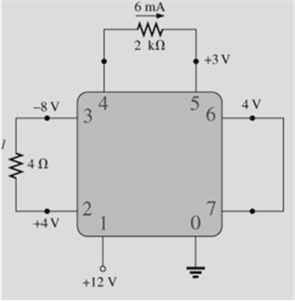
Concept explainers
For the integrated circuit in Fig. 5.131, determine

Want to see the full answer?
Check out a sample textbook solution
Chapter 5 Solutions
Laboratory Manual for Introductory Circuit Analysis
Additional Engineering Textbook Solutions
Modern Database Management
Automotive Technology: Principles, Diagnosis, And Service (6th Edition) (halderman Automotive Series)
Web Development and Design Foundations with HTML5 (8th Edition)
Starting Out with Programming Logic and Design (5th Edition) (What's New in Computer Science)
Starting Out with C++: Early Objects (9th Edition)
Thermodynamics: An Engineering Approach
- HANDWRITTEN SOLUTION DO NOT USE AIarrow_forwardGiven the following voltage divider, R1 is fixed and R2 is implemented using two terminals of a 10k pot so that R2 is a variable over the range of 0<=R2<= 10 kiloolhm. V1 is a voltage source from a 9 V battery. What is the largest value of R1 that will allow the output voltage to vary over a range that includes at least 1.5V<= V2 <= 5.0V. Then, determine a resistor (or a combination of resistors) of standard type you might that will get as close as possible to but not larger than the calculated value of R1.arrow_forwardFind the Thevenin And Norton equivalent circuit for nodes a and b. Do not use chatgpt or AIarrow_forward
- Given the following voltage divider circuit, where V1 is a 9V battery, R1 is implemented using two terminals of a 10k pot so that R1 is a variable over the range 0 <= R1 <= 10kiloohlm. What is the largest value of the resistor R1 that will permit the output voltage to vary over the range that includes at least 1.5V <= V2 <= 5.0 V? Then, find a resitor (or a combinations of resistors) that are common types that would get as close as possible but not larger than the calculated value for R2.arrow_forwardGiven the following voltage divider circuit, both resistors R1 and R2 are implemented using the three terminals of a 10k pot so that R1 and R2 are both variables such that 0<=R2 <=10kiloolhms and R1 +R2 = 10kiloolhms. V1 is a 10V battery voltage source. Find the range of values for R2 that wil cause the output voltage to vary over the range 1.5V<= V2<= 5.0V.arrow_forward1. Laboratory Task Descriptions Verification of series RLC transient analysis computations For this laboratory exercise, students will construct an underdamped series RLC circuit, then make voltage and current measurements to investigate the validity of transient circuit analysis techniques for series RLC circuits. Measurements will be obtained using the oscilloscopes available in the laboratory. The signal generator will be used to apply a 0[V] to 10[V], 50[%] duty cycle square wave across the RLC circuit to establish the circuit response. The required square wave signal frequency for the RLC circuit will be computed below in part 2b of the prelab work. Note: To receive credit for the following prelab computations, all required equations for the prelab below must be generated in variable form before substituting component values. Generation of the equations in variable form is required to permit substituting the actual measured component values into the solution equations. This…arrow_forward
- 1. Laboratory Task Descriptions Verification of series RLC transient analysis computations For this laboratory exercise, students will construct an underdamped series RLC circuit, then make voltage and current measurements to investigate the validity of transient circuit analysis techniques for series RLC circuits. Measurements will be obtained using the oscilloscopes available in the laboratory. The signal generator will be used to apply a 0[V] to 10[V], 50[%] duty cycle square wave across the RLC circuit to establish the circuit response. The required square wave signal frequency for the RLC circuit will be computed below in part 2b of the prelab work. Note: To receive credit for the following prelab computations, all required equations for the prelab below must be generated in variable form before substituting component values. Generation of the equations in variable form is required to permit substituting the actual measured component values into the solution equations. This…arrow_forwardI need handwritten solution to this question,no Artificial intelligencearrow_forwardDO NOT USE AI NEED HANDWRITTEN SOLUTION For the circuit below a. For the load to consume 39 watts, what is the value of the resistor ‘R’? b. When the load is consuming 39 watts, what is the magnitude of the current through the resistor ‘R’? c When the load is consuming 40 watts, what is the power delivered by the 100 V source?arrow_forward
- A). Find the inverse of matrix A using Gauss Elimination method. 1 0 01 A = -2 1 0 5 -4 1 B). Use fixed point iteration method to solve f(x)=sin(√√x) - x, take n = 5 and initial value x 0.5.arrow_forwardThe joint pdf of random variables X=1, 2 and Y=1, 2, 3 is P(X,Y) = X [0.0105 Find (a) The value of k. (c) P(X21, Y £2). Y 0.2 0.15] 0.18 (b) the marginal probability function of X and Y. (d) x, Hyarrow_forwardUse Gauss Elimination method to solve the following systems of linear equations. x13x24x3 8 3x1 -x2+5x3 7 4x1+5x2 - 7x3 = 2.arrow_forward
 Introductory Circuit Analysis (13th Edition)Electrical EngineeringISBN:9780133923605Author:Robert L. BoylestadPublisher:PEARSON
Introductory Circuit Analysis (13th Edition)Electrical EngineeringISBN:9780133923605Author:Robert L. BoylestadPublisher:PEARSON Delmar's Standard Textbook Of ElectricityElectrical EngineeringISBN:9781337900348Author:Stephen L. HermanPublisher:Cengage Learning
Delmar's Standard Textbook Of ElectricityElectrical EngineeringISBN:9781337900348Author:Stephen L. HermanPublisher:Cengage Learning Programmable Logic ControllersElectrical EngineeringISBN:9780073373843Author:Frank D. PetruzellaPublisher:McGraw-Hill Education
Programmable Logic ControllersElectrical EngineeringISBN:9780073373843Author:Frank D. PetruzellaPublisher:McGraw-Hill Education Fundamentals of Electric CircuitsElectrical EngineeringISBN:9780078028229Author:Charles K Alexander, Matthew SadikuPublisher:McGraw-Hill Education
Fundamentals of Electric CircuitsElectrical EngineeringISBN:9780078028229Author:Charles K Alexander, Matthew SadikuPublisher:McGraw-Hill Education Electric Circuits. (11th Edition)Electrical EngineeringISBN:9780134746968Author:James W. Nilsson, Susan RiedelPublisher:PEARSON
Electric Circuits. (11th Edition)Electrical EngineeringISBN:9780134746968Author:James W. Nilsson, Susan RiedelPublisher:PEARSON Engineering ElectromagneticsElectrical EngineeringISBN:9780078028151Author:Hayt, William H. (william Hart), Jr, BUCK, John A.Publisher:Mcgraw-hill Education,
Engineering ElectromagneticsElectrical EngineeringISBN:9780078028151Author:Hayt, William H. (william Hart), Jr, BUCK, John A.Publisher:Mcgraw-hill Education,





